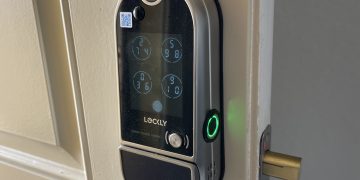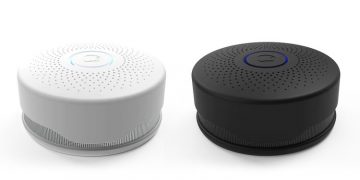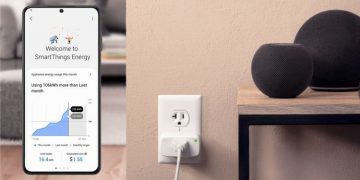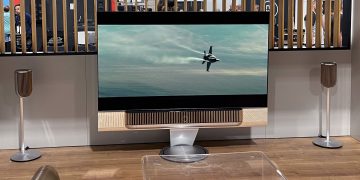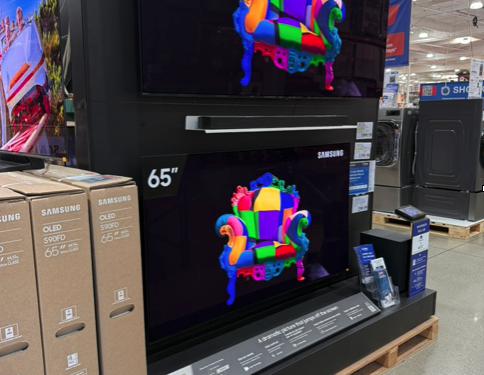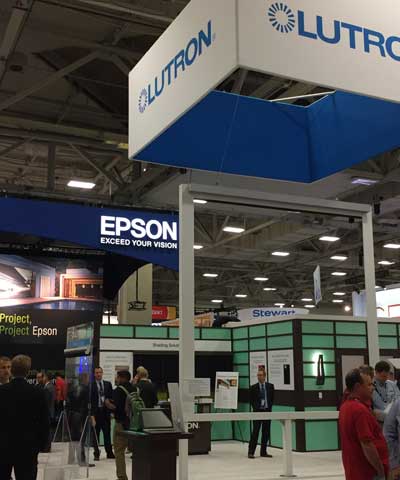Part 2 Which to TV Technology To Choose?
After OLED, in picture quality and price, the next step “down” are TVs with mini-LED backlighting, most referred to as Quantum TVs
Non-OLED TVs: QLEDs and “Standard” LED TVs
I mentioned in the previous article in this series that OLED picture quality remains essentially consistent, even if you are viewing from side angles. Here’s two pictures of my Hisense Quantum TV, one from straight ahead, and the other from well off to the side. It’s easy to see that picture quality deteriorates a good bit, especially from far to the side.


Quantum TVs – Without getting into the “Quantum” technology (let’s think of it as being as much a marketing name as advanced physics and nano films.) Many of these have “mini-LED” technology, which are tied to what are called “zones.” Zones are important to improve picture quality on dark scenes. Here’s why.
Zones, Mini-LEDs: For many years (LED TVs – which used to be called LCD TVs) all were “backlit” with a single light source around the edges (called “edge lit”) backlight responsible for providing the backlight for all the pixels that make up the picture.
That is, a white light source passes light through the LEDs. The data feeding the color LEDs determined the color that passed through and hits your eyes. The problem: Traditional LEDs leak light so that if the data said, this pixel should be black – that was impossible because of the white light that leaks through. The result – black turns out to be darkish gray or lighter, and that translates to a picture with poorer contrast. That’s how all types of LEDs work except for OLED. More on that, in a minute.
One light source for the entire TV was how they had been designed. An entire scene, for example might be a very dark night scene with a single bright street light. In order for the street light to appear nice and bright, the TV’s backlight needs to be bright to pass a lot of light through the LEDs. But the brighter the backlight, the more light passes through all the pixels, even the ones that call for no light to come through. That’s the failing of non OLED LEDs. The result is that the dark scene ends up more grey, less dark than it should be.
With zones, instead of a single backlight source there can be dozens or even thousands of separate lighting zones, each separately controlled. The more zones, the better the handling of those dark scenes – ie. only the backlight of the zone with the street light needs to be bright. All the other zones can be dimmed so less light leaks through, resulting in the picture in all those other zones appearing darker, closer to pure black. Closer to what the image calls for.
My own 100” HiSense has 1620 separate zones! Some have many times that many. This means each zone can be really small. Now the number or zones will affect price. For example, my TV is what HiSense calls their U8 series. The less expensive U6 series (shown in the picture above) has merely 192 zones. More is better. But no matter how many zones, OLED is still better at producing blacks, and with that, a better picture overall.
Lower cost, basic LED TVs:
While picture quality continues to improve, and prices continue to fall, your standard LED TV can’t match the multi-zone Q type (with their “nano structure” LEDs) and “mini-LED” light sources, that is, they can’t match the Quantum TV’s picture quality. The thing is, for most folks those TVs are just fine, Q’s are better, etc. Even the most basic ones have better looking pictures than that LED TV you bought 10 or 15 years ago. And, of course the prices are lower. Note, by the time you are looking at sets 77” and larger sizes, almost all the sets are multi-zone and with other more advanced technology than what you find, on say a typical 43” TV – which these days start under $200! 42” Plasma TVs were $25,000+ 25 years ago!
Price Comes Into Play
Prices vary a lot between technologies. So, to paint a picture for you (so to speak) here of how prices can run. I checked out prices on different Samsung 43” TVs at Best Buy:
Their most basic 43” is currently $219 while a starter Q (quantum) is $399, and their top of the line multi-zone Q, mini-led is $1299. Samsung, however has at least a half dozen other models between that $399 and $1299. Oddly Samsung even has an OLED that’s less than their top of the line Q mini-LED (not sure why that is, but they also have even more expensive OLEDs).
I will remind you again, one advantage of QLEDs is that they are definitely a good bit brighter than OLED. Still that’s not an issue except in very bright rooms (daylight pouring in)
If you aren’t into watching movies or like to stream lots of content that tends to be very, very dark, then the zones aren’t that important. Keep that in mind when working on your budget vs size vs which technology.
Bottom line: As to Which Technology – from most perspectives:
Bigger is Better! (If you have room.)
OLED offers the best picture, and can produce pure blacks for the best saturation and contrast, and look just as good off angle as straight ahead. OLED prices are the highest, but still not insane – considering a 77” can be well under $2000, but the largest OLEDs – 97” – 100” are still stratospherically priced with list prices starting well over $10,000 (but are still a whole lot less expensive than 2 years ago – when $25K was the street price).
Q (Quantum) type TVs are next best – with the “mini-LEDs” the best of that class, the more zones the better. And they are the brightest. But they will roll off in picture quality if you view from off angle. Most folks will find the picture of Q type min-LED sets to have an awesome picture. It’s the folks looking for the best picture that seek out OLED.
Standard LED TVs typically just have a single zone, and cost the least, have the least contrast to their picture.
Enough. I hope, so far, that this has helped you decide what type of TV will be best for your room, your viewing and your budget. Check out the 3rd and last article in this series:

